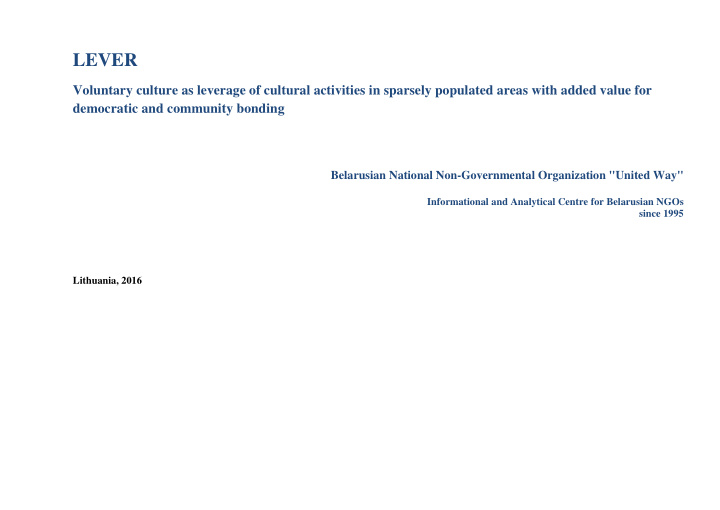



LEVER Voluntary culture as leverage of cultural activities in sparsely populated areas with added value for democratic and community bonding Belarusian National Non-Governmental Organization "United Way" Informational and Analytical Centre for Belarusian NGOs since 1995 Lithuania, 2016
At present, Belarusian villages are characterized by specific economic, structural, demographic, cultural features: • inefficient production strategy • degradation of social infrastructure deepened due to economic strategy aimed at creation of the so-called agro-towns • imperfect transport infrastructure • predominance of women in the population, especially vivid in the elder age groups • low level of education
Economic strategy aimed at creation of the so-called agro-towns in this country contributed to degradation of social infrastructure of small settlements, leading to disproportion between large and small villages. Table 1 Quantity and structure of the population depending of the type of settlement (%) Agro-towns Teams’ centers Small villages ( Центры «бригад») population 54 33 13 children 72 21 7 capable to work 76 21 3 pensioners 19 35 46 Table 2 Territorial distribution of small settlements and population of small villages (average in the country within average administrative district) Distance from a district center, km below 10 20 30 over 30 Population per 100 square km 20 16 9 7 Population per one settlement 19 17 15 11
The population of villages has a strong need for reintegration into economic, social and cultural relation networks, which will provide an opportunity to live and develop decently. Pogost village Zhitkovichy district
Structural and cultural changes occurring during the past years, as well as gender-age, educational and social structure of the population in sparsely populated areas (remote small villages) give grounds to state the following objectives of the proposed project : • enhanced studying of economic, social, and cultural potential of small villages; • identification of local NGOs acting in the respective field, and potential local leaders; • identification of initiatives which are of interest for the population; • familiarization of local administrators (officials) and local NGOs with the project; • involvement of specialists in the fields of ecotourism, hotel business, release of ecologically clean production, traditional medicine, ancient skills, folklore to interaction with the local population and administration; • integration of efforts of all interested parties on the basis of reconstruction of the network of settlements as an ancient cultural complex
To achieve the objectives, the following activities are planned: • polling in small villages in order to reveal a real economic, social, and cultural situation; • conduct of project issues-related seminars with local activists, workers of local NGOs, members of self-government bodies, workers of local administration; • meeting with the population of small villages (three stages): а ) familiarization with the findings of household polling, and problem statement; b) discussion of problems; c) decision making
Suggested content and form in local courses • Seminars (on the basis of prepared methodological materials) for workers of local NGOs, activists, self-government and administration; • Arts and crafts courses; guest sessions – master classes, patronage-mentoring, traineeships for practitioners; (The topics will be selected after identification of priority wishes and opportunities. Examples: Cultivation, gathering, treatment, storage and use of medicinal herbs; Traditional knitting; or Organization of traditional sports games for children and adults; etc.).
Project evaluation Quality indicators: • rate of coincidence of factual and anticipated results; • appraisal of results by the population/active group; • appraisal of results by the press/ administration at all levels; • evaluation of the project results by the sponsors. Evaluation procedure: • acquisition of data; • preparation of the report/ evaluation of the report by the sponsors;
Dissemination of the project course and results: • printed materials based on the results of events; • placement of information at WWW.NGO.BY Portal A “seesaw” scheme of information dissemination is planned: UWB Portal – local web-sites – media – UWB Portal • placement of information at other Internet resources (web-sites of village councils, villages (if any); • placement of information in social networks (on UWB FB and VK pales and on local activists’ pages); • submission of information to the local press; • dissemination of information through the UWB E-Mailing System • dissemination of information through private conversations with interested persons/ call centers;
Local concept materials The preliminary list of materials: - Renewal of villages: from state programs to strivings of enthusiasts. Inna Garmel - Agro-tourism in Belarus - Traditional Belarusian Village in the European Perspective. V. Nosevich - Museum of Old Belief and Belarusian Traditions. Vetka - Textile traditions in Neglyubka village Vetka district - Ethno-Tourism in Belarus - Museum of ancient arts and crafts - Belarusian Folk Belts The list will be complemented. Belarusian Folk Belts
Belarusian National NGO "United Way Belarus" uwb@ngo.by www.ngo.by Vkontakte: http://vk.com/ngoby Twitter: https://twitter.com/ngo_by Facebook: https://www.facebook.com/likengoby
Recommend
More recommend